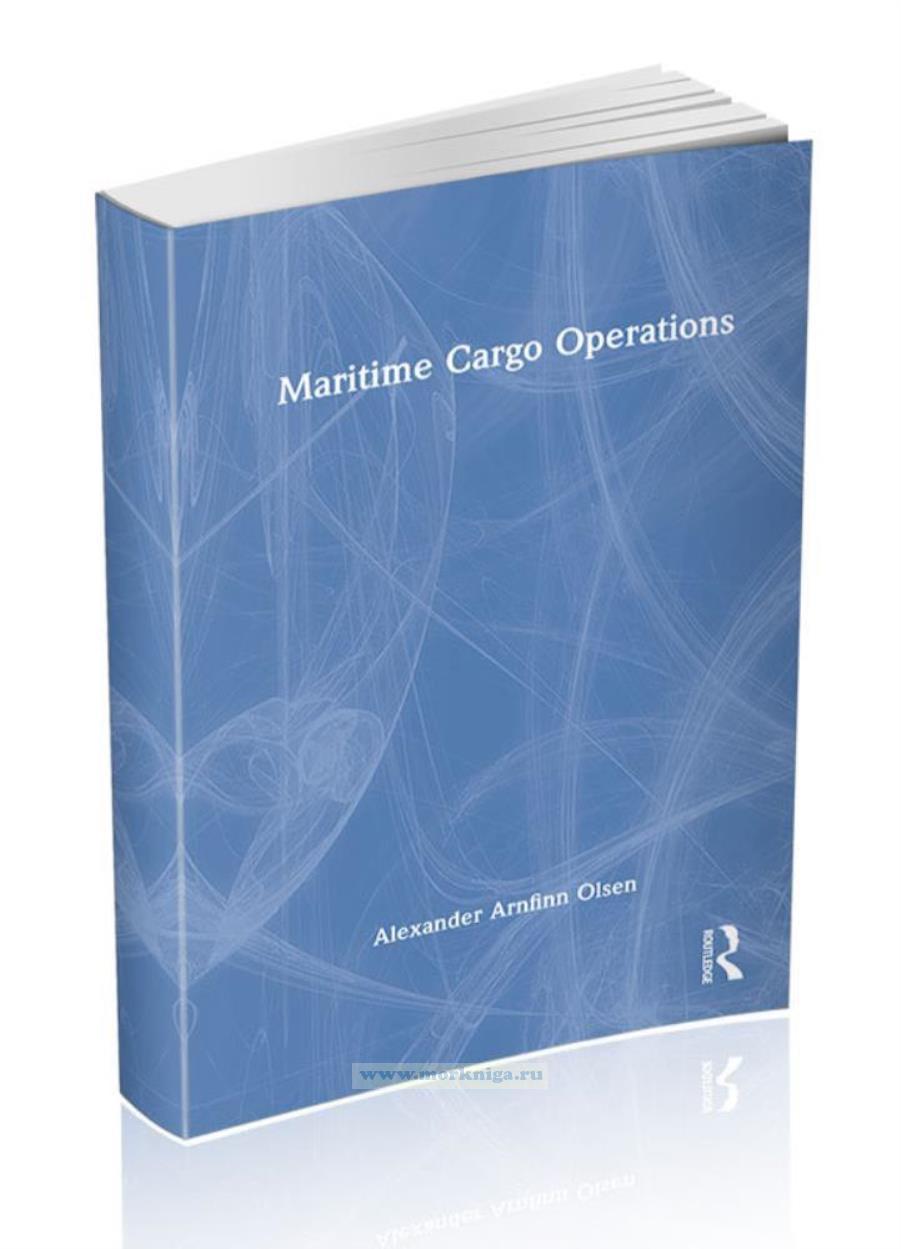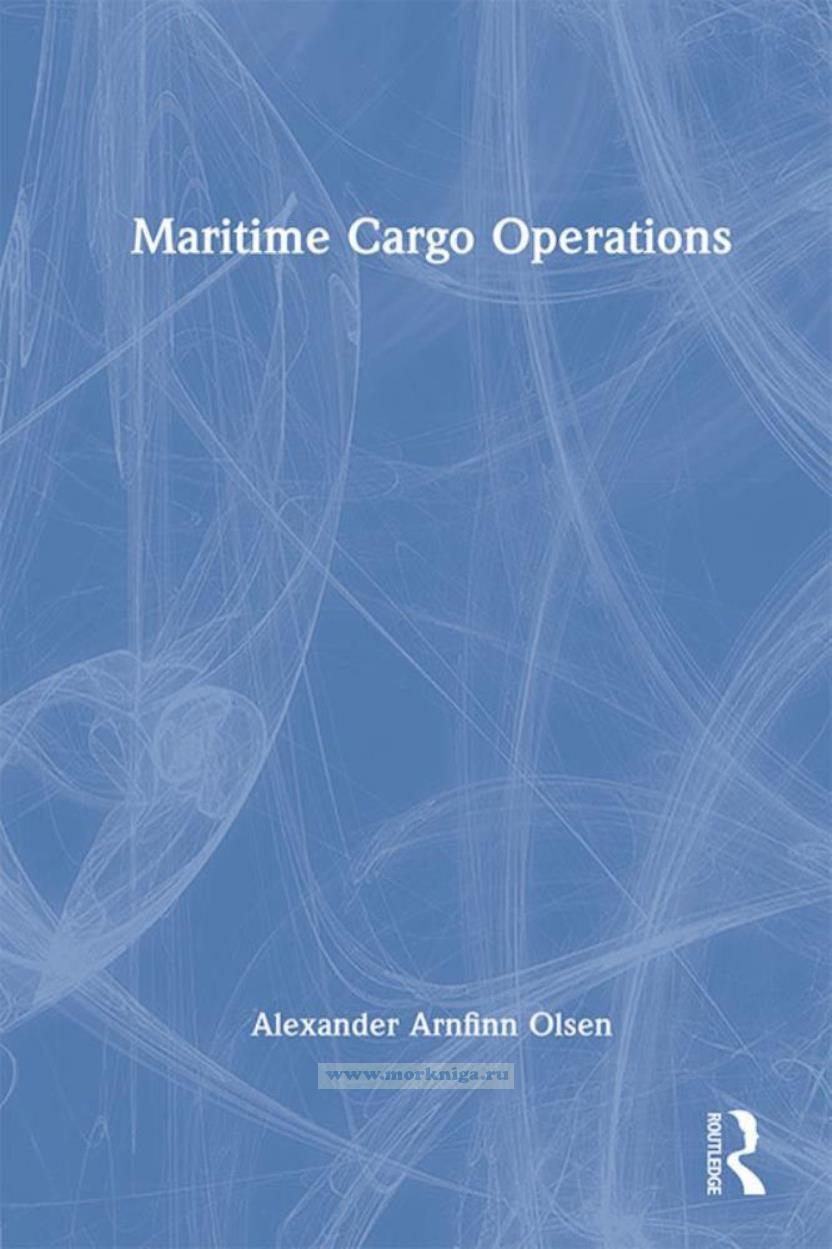Maritime Cargo Operations/Морские грузовые операции
Книга на английском языке.
Maritime Cargo Operations presents the core concepts of cargo work for marine engineering students and cadets. It is built around the essential principles of the maritime profession and is a valuable guide to a broad range of key subject areas in the safe carriage, handling, stowage and securing of cargo, and cargo watches in port. It contributes to a sound understanding of cargo operations for a future career in the profession, as well as offering a general overview for deck officers.
Gives an overview of the key areas in cargo operations work.
Includes structured Learning Outcomes and self-test questions for each subject area to assist readers in evaluating their understanding.
The book suits merchant navy cadets at Higher National Certificate (HNC), and Higher National Diploma (HND), and foundation degree level in both the deck and engineering branches, and also serves as a general reference for maritime professionals.
Contents
Preface
Acknowledgements
List of Figures
List of Tables
Key Terms
PART I Safe Carriage of Cargo: Principles and Practice
1 Key Concepts of Cargo Work
1.1 Introduction
1.2 Key Concepts of Cargo Work
1.2.1 Fruit Carriers
1.2.2 Gas Carriers
1.2.3 LASH Vessels
1.2.4 Multipurpose General Cargo Ships
1.2.5 Refrigerated Vessels
1.2.6 Roll-on Roll-off Vessels
1.2.7 Tankers
1.2.8 Timber Carriers
1.2.9 Vehicle Carriers
1.2.10 Others
2 Determining Cargo Quantity and Volume
2.1 Terms Used for Measurement
2.2 Terms Used for Weight and Quantity
2.3 Draught Survey
2.3.1 Contextual Example
3 Ballast Management
3.1 Introduction
3.2 Risks Involved with the Exchange of Ballast Water
3.3 Ballast Water Management Guidelines
3.3.1 Ballast Water Management Plan
3.3.2 Ballast Water Record Books
3.3.3 Ballast Water Management Standards
3.3.4 Sediment Management for Ships
3.3.5 Duties of Offcers and Crew
3.3.6 Exceptions
3.3.7 Exemptions
3.3.8 Equivalent Compliance
3.4 Survey and Certifcation of Ships
3.5 Ballast Water Management Standards
3.5.1 D1 - Ballast Water Exchange (BWE)
3.5.2 D2 - Ballast Water Performance Standard
3.6 Other Methods of Ballast Water Management
3.7 Ballast Water Management Implementation Schedule
3.8 UK Implementation of the Ballast Water Management Convention
3.9 Ballast Water Management Requirements in Specifc Marine Areas
3.10 Case Study: Australian Ballast Water Management Requirements
3.10.1 Background
3.10.2 What the New Arrangements Mean for the Shipping Industry Mandatory Ballast Water Management Requirements
3.10.3 Ballast Water Management Options
3.10.4 The AQIS Decision Support System
3.10.5 Ballast Water Reporting
3.10.6 Verifcation Inspections
3.10.7 AQIS Ballast Water Compliance Agreements
3.10.8 Tank Stripping
3.10.9 Access to Sampling Points
4 Principles for the Safe Handling, Stowage, and Carriage of Dry Cargoes
4.1 Introduction
4.2 What Is General Cargo?
4.3 Equipment Used in the Handling of General Cargo
4.4 Safe Handling, Stowage, and Carriage of Typical General Cargoes
4.5 Cargo Hold Preparation for the Reception of General Cargo
4.6 Unitisation
4.7 Containerisation
4.8 Preparations for Containerised Cargo
4.8.1 Preparing a Cargo Space to Load Containerised General Cargo
4.9 Examples of Common Types of Containers
4.10 Identifying a Container’s Location
4.11 Refrigerated and Reefer Cargoes
4.11.1 Frozen Cargo
4.11.2 Chilled Cargo
4.11.3 Temperature-regulated Cargo
4.12 Safe Handling, Stowing, and Carriage of Reefer Cargoes
4.12.1 Pre-cooling of Compartment
4.12.2 Loading and Handling
4.12.3 CO2 Control
4.12.4 Methods of Transportation of Reefer Cargoes
4.12.5 Loose and Unitised Reefer Cargoes
4.13 Containerised Reefer Cargoes
4.13.1 Ship-dependent Containers
4.13.2 Independent Containers
5 Principles for the Safe Handling, Stowage, and Carriage of RORO Cargo
5.1 Introduction
5.2 RORO Cargo Operations
5.2.1 Rolling Cargo
5.2.2 Vehicles
5.2.3 Containers
5.3 Guidance for Cargo Offcers Overseeing RORO Operations
5.3.1 General Precautions
5.3.2 Ventilation
5.3.3 Fire Safety and Prevention
5.3.4 Noise
5.3.5 Safe Movement
5.3.6 Use of Work Equipment
5.3.7 Inspection of Vehicles
5.3.8 Stowage
5.3.9 Securing of Cargo
5.3.10 Dangerous Goods
5.3.11 Specialised Vehicles
5.3.12 Partially Filled Tank Vehicles
5.3.13 Housekeeping
5 Principles for the Safe Handling, Stowage, and Carriage of Dry Bulk Cargo
5.1 Introduction
5.2 The Loading and Handling of Dry Bulk Cargoes
5.3 Principles and Practice for the Safe Handling, Stowage, and Carriage of Some Special Types of Solid Bulk Cargo Concentrates
5.4 Preparing a Space for the Reception of Dry Bulk Cargo
5.4.1 Exceptions
5.5 Summary
5 Principles for the Safe Handling, Stowage, and Carriage of Liquid Bulk Cargo
5.1 Introduction
5.2 Carriage of Petroleum Products
5.3 Cargo-handling Procedures for Clean Oils
5.4 Cargo-handling Procedures for Dirty Oils
5.5 Crude Oil Washing
5.6 Principles of the Inert Gas Systems
5.7 Preparation of Cargo Spaces for the Reception of Bulk Liquid Cargo
8 Principles for the Safe Handling, Stowage, and Carriage of Liquefed Gases
8.1 Introduction
8.2 Cargo Operations on Gas Carriers
8.3 Guidelines for Completing the Ship to Shore Safety Checklist
8.4 Ship/Shore Safety Checklist
9 Principles for the Safe Handling, Stowage, and Carriage of Cargo on Offshore Supply Vessels
9.1 Introduction
9.2 Preparing to Load Cargo Onboard
9.3 Notifcation of Any Unusual Cargo Items
9.4 Deck Space Management and Back Load Cargoes
9.5 Cargo Plans
9.6 Sailing Instructions
9.7 Potential Dropped Objects
9.8 Stowage and Securing of Cargoes in Containers
9.9 Refrigerated Containers (Disconnection at the Offshore Facility)
9.10 Tubular Cargo
9.11 Main Block Operations
9.12 Cherry Picking
9.13 Unusual Cargo Items Loaded onto Vessel Decks
9.14 Bulk Cargo General Requirements
9.15 Bulk Operations in Port and at the Facility
9.15.1 Vessel Responsibilities at the Facility
9.15.2 Facility Responsibilities
9.16 Preparations Relating to the Transfer of Dry Bulk Materials
9.17 Bulk Hose-Handling Procedures at the Facility
9.18 Hose Securing Arrangements
9.19 Bulk Transfers of Common Liquids
9.20 Bulk Transfers of Special Products
9.20.1 Characteristics of Some Special Liquid Products
9.21 Attendance of Facility Personnel during Bulk Transfer Operations
9.22 Transfer of Noxious Liquids during the Hours of Darkness
9.22.1 Tank Cleaning
9.22.2 Control
9.23 Carriage of Tubular Cargoes
9.23.1 Cargo Requirements
9.23.2 Preparations before Loading at Base
9.23.3 Loading at Base
9.24 Offshore Loading/Offoading Operations
9.25 Loading of Tubular Cargo onto Pipelaying Vessels
9.26 Carriage of Oil-contaminated Cargo
9.27 Composition of the Wet Bulk Waste
10 Principles for the Safe Handling, Stowage, and Carriage of Timber Products, Grain, and Livestock
10.1 Introduction
10.2 Timber
10.3 Stability Criteria for Vessels Carrying Timber Deck Cargo
10.4 Precautions Necessary When Carrying Timber Deck Cargo
10.4.1 Timber and Cargo Securing
10.4.2 Load Line
10.5 Regulation 44 - Stowage
10.5.1 General
10.5.2 Uprights
10.5.3 Lashings
10.5.4 Stability
10.5.5 Protection of Crew, Access to Machinery Spaces, etc.
10.5.6 Steering Arrangements
10.6 Regulation 45 - Computation for Freeboard
10.6.1 Securing
10.6.2 Summary
10.7 Grain
10.8 Stowage of Bulk Grain
10.8.1 Germination
10.8.2 Infestation
10.8.3 Dust Explosion
10.8.4 Grain Swelling
10.8.5 Grain Shifting (in a Filled Compartment)
10.8.6 Grain Shifting (in a Partly Filled Compartment)
10.9 Vessel Stability
10.10 Livestock
10.11 Loading Procedures (Australia)
10.12 Stability Criteria for Vessels Carrying Livestock
10.13 Restrictions on the Carriage of Livestock
10.14 Provision of Ventilation, Lighting, and Drainage
10.15 Provision of Firefghting Appliances
Part 2 Safe Handling, Stowage, and Securing of Cargo
Learning Outcome 2
Assessment Criteria
11 Requirements Relating to the Use of Cargo- handling Equipment and Cargo Stowage
11.1 Introduction
11.2 Key Terms and Defnitions
11.3 Loading and Unloading Operations
11.3.1 Safe Working Loads
11.3.2 Testing, Examination, Inspection, and Certifcation of Wire Rope
11.3.3 Register of Materials-handling Equipment and Certifcates of Testing
11.3.4 Provision of Protective Fencing
11.3.5 Provision of Lighting
11.3.6 Provision of Safe Atmospheres
11.3.7 Provision of Fire Extinguishing Systems and Equipment
11.3.8 Safe Use of Materials-handling Equipment
11.4 Requirements for Derricks
11.5 Requirements for Cargo Gears
11.6 Signalling
11.7 Handling and Stowage of Different Cargoes Using Machinery
11.7.1 Handling of Bulk Cargo
11.7.2 Handling of Bulk Liquid
11.7.3 Handling of Containers
11.7.4 Handling of Cargo on RORO Vessels
11.7.5 Handling Heavy Weights
11.8 Hold and Tank Preparation Procedures for the Reception of Various Cargoes
11.9 Fumigation and De-odourisation of Cargo Holds
11.9.1 Fumigation
11.9.2 Part A - General Information on All Quarantine Treatments
11.9.3 De-odourisation
12 Importance of Cargo Securing and Cargo Care
12.1 Introduction
12.2 Main Objectives of Cargo Securing
12.3 Securing of Cargoes
12.3.1 Securing General Cargoes
12.3.2 Securing of Coils
12.3.3 Securing of Logs and Timber Products
12.3.4 Securing of Cargo on RORO Ships
12.3.5 Securing of Containers
12.3.6 Securing of Heavy Loads
12.4 Dunnage
12.5 Cargo Damage: Causes, Effects, and Prevention
12.6 Temperature-controlled Reefer Cargo
12.6.1 Types of Reefer Containers
12.7 Sweat: Causes, Effects, and Prevention
12.7.1 Examples of Ship Sweat and Cargo Sweat
12.8 Cargo Contamination
12.8.1 Contamination by Taint
12.8.2 Contamination through Fumigation
12.8.3 Contamination by Water
12.8.4 Cross-Cargo Contamination
12.9 Cargo Damage Survey Procedure
12.10 Summary
13 Safe Handling, Stowage, and Carriage of IMDG Cargo
13.1 Introduction
13.2 Structure of the IMDG Code
13.2.1 Subclass
13.2.2 The UN Number
13.2.3 General Index
13.2.4 Segregation
13.2.5 Labelling
13.2.6 Subsidiary Risk Label
13.2.7 Marine Pollutant
13.2.8 Packaging Group
13.2.9 Emergency Schedule Number
13.2.10 Medical First Aid for Use in Accidents Involving Dangerous Goods Table Number
13.3 Classifcations of Dangerous Goods
13.3.1 Class 1: Explosives
13.3.2 Class 2: Flammable Gases
13.3.3 Class 3: Flammable Liquids
13.3.4 Class 4.1: Flammable Solids
13.3.5 Class 4.2: Flammable Material Liable to Spontaneous Combustion
13.3.6 Class 4.3: Flammable Materials that Are Dangerous When Wet
13.3.7 Class 5.1: Oxidising Substances
13.3.8 Class 5.2: Organic Peroxides
13.3.9 Class 6: Poisonous Substances
13.3.10 Class 7: Radioactive Substances
13.3.11 Class 8: Corrosives
13.3.12 Class 9: Miscellaneous
13.4 Markings of Dangerous Goods
13.4.1 Class 1: Explosives
13.4.2 Class 2: Gases
13.4.3 Class 3: Flammable Liquids
13.4.4 Class 4: Flammable Solids
13.4.5 Class 5: Oxidising Substances and Organic Peroxides
13.4.6 Class 6: Poisonous Substances and Infectious Substances
13.4.7 Class 7: Radioactive Substances
13.4.8 Class 8: Corrosives
13.4.9 Class 9: Miscellaneous Substances
13.5 Safety Precautions and Procedures during Cargo Operations
13.6 Actions in the Event of Leakage or Spillage
13.7 Procedures to Follow When Shipping Dangerous Goods
13.8 Proposed Loading Plans and Final Stowage Plans
13.9 Precautions during the Loading, Carriage, and Discharge of Dangerous Goods
13.9.1 General Fire Precautions to Be Taken When Carrying Dangerous Goods
13.9.2 Segregation
13.9.3 Packing
Part 3 Cargo Watches in Port and Officer of the Watch Responsibilities 253
Learning Outcome 3
Assessment Criteria
14 Duties and Responsibilities with respect to Cargo Operations
14.1 Introduction
14.2 Duties of the Offcer of the Watch in the Port of Loading
14.3 Duties of the Chief Offcer in the Port of Loading
14.4 Hatch and Cargo Gear Preparations
14.5 Safety Checks to Be Carried Out before Starting Cargo Operations
14.6 Offcer of the Watch Responsibilities with respect to the Ship’s Staff, Stevedores, and Visitors
14.6.1 Crew and Vessel
14.6.2 Visitors
14.7 Safety Precautions with respect to Port Watchkeeping
14.8 Taking and Handing over the Port Watch
14.9 Importance of Establishing and Maintaining Effective Communications
14.10 Guidelines for Completing the Ship/Shore Safety Checklist
14.11 Summary
15 Cargo Planning, Record, and Log Keeping
15.1 Pre-loading and Cargo Plan
15.2 Capacity, Lashing, and Rigging Plans
15.2.1 Capacity Plan
15.2.2 Lashing Plan
15.2.3 Rigging Plan
15.3 Record and Log Keeping
15.4 Damage Report
15.5 Important Shipping Documents
Index

